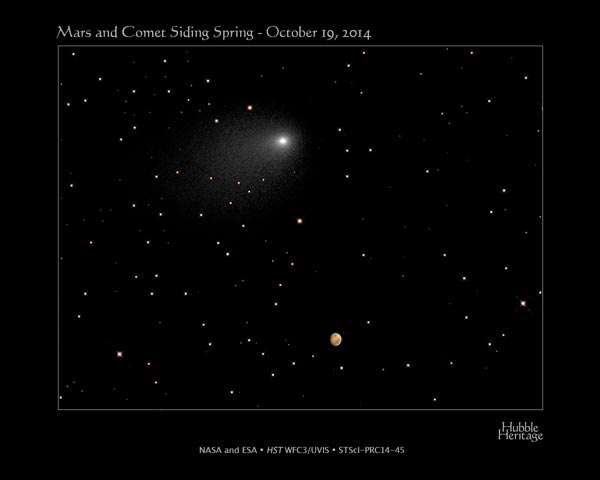Close Encounters: Comet Siding Spring Seen Next to Mars

NASA, ESA, J.-Y. Li (PSI), C.M. Lisse (JHU/APL), and the Hubble Heritage Team (STScI/AURA) This composite NASA Hubble Space Telescope image captures the positions of comet Siding Spring and Mars in a never-before-seen close passage of a comet by the Red Planet, which happened at 2:28 p.m. EDT October 19, 2014. The comet passed by Mars at approximately 87,000 miles (about one-third of the distance between Earth and the Moon). At that time, the comet and Mars were approximately 149 million miles from Earth. The comet image shown here is a composite of Hubble telescope exposures taken between October 18, 8:06 a.m. EDT to October 19, 11:17 p.m. EDT. Hubble took a separate photograph of Mars at 10:37 p.m. EDT on October 18.
On that date the comet passed by Mars at approximately 87,000 miles (about one-third the distance between Earth and the Moon). At that time, the comet and Mars were approximately 149 million miles from Earth.
The comet image shown here is a composite of NASA Hubble Space Telescope exposures taken between October 18, 8:06 a.m. EDT and October 19, 11:17 p.m. EDT. Hubble took a separate photograph of Mars at 10:37 p.m. EDT on October 18.
The Mars and comet images have been added together to create a single picture to illustrate the angular separation between the comet and Mars at closest approach. The separation is approximately 1.5 arcminutes, or 1/20th of the angular diameter of the full Moon.
The background starfield in this composite image is synthesized from ground-based telescope data provided by the Palomar Digital Sky Survey, which has been reprocessed to approximate Hubble's resolution. The solid, icy comet nucleus is too small to be resolved in the Hubble picture. The comet's bright coma, a diffuse cloud of dust enshrouding the nucleus, and a dusty tail, are clearly visible.
This is a composite image because a single exposure of the stellar background, Comet Siding Spring, and Mars would be problematic. Mars is actually 10,000 times brighter than the comet, and so could not be properly exposed to show detail in the Red Planet.
The comet and Mars were also moving with respect to each other and so could not be imaged simultaneously in one exposure without one of the objects being motion blurred. Hubble had to be programmed to track on the comet and Mars separately in two different observations.
The images were taken with Hubble's Wide Field Camera 3.
Credit: NASA, ESA, J.-Y. Li (PSI), C.M. Lisse (JHU/APL), and the Hubble Heritage Team (STScI/AURA)
For images and more information about comet Siding Spring and Mars, visit:
http://hubblesite.org/news/2014/45
http://www.nasa.gov/hubble
http://heritage.stsci.edu/2014/45
For additional information, contact:
Ray Villard
Space Telescope Science Institute, Baltimore, Md.
410-338-4514
villard@stsci.edu
Zolt Levay
Space Telescope Science Institute, Baltimore, Md.
410-338-4907
levay@stsci.edu
Jian-Yang Li
Planetary Science Institute, Tucson, Ariz.
571-488-9999 or 301-367-6315
jyli@psi.edu
Carey Lisse
The Johns Hopkins University Applied Physics Laboratory, Laurel, Md.
240-228-0535 or 443-778-0535
carey.lisse@jhuapl.edu
The Hubble Space Telescope is a project of international cooperation between NASA and the European Space Agency. NASA's Goddard Space Flight Center in Greenbelt, Md., manages the telescope. The Space Telescope Science Institute (STScI) in Baltimore conducts Hubble science operations. STScI is operated for NASA by the Association of Universities for Research in Astronomy, Inc., in Washington, D.C.
Media Contact
All latest news from the category: Physics and Astronomy
This area deals with the fundamental laws and building blocks of nature and how they interact, the properties and the behavior of matter, and research into space and time and their structures.
innovations-report provides in-depth reports and articles on subjects such as astrophysics, laser technologies, nuclear, quantum, particle and solid-state physics, nanotechnologies, planetary research and findings (Mars, Venus) and developments related to the Hubble Telescope.
Newest articles

Silicon Carbide Innovation Alliance to drive industrial-scale semiconductor work
Known for its ability to withstand extreme environments and high voltages, silicon carbide (SiC) is a semiconducting material made up of silicon and carbon atoms arranged into crystals that is…

New SPECT/CT technique shows impressive biomarker identification
…offers increased access for prostate cancer patients. A novel SPECT/CT acquisition method can accurately detect radiopharmaceutical biodistribution in a convenient manner for prostate cancer patients, opening the door for more…

How 3D printers can give robots a soft touch
Soft skin coverings and touch sensors have emerged as a promising feature for robots that are both safer and more intuitive for human interaction, but they are expensive and difficult…





















